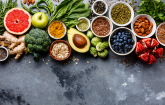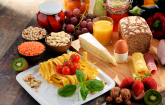
Natural food colors are pigments derived from natural sources such as fruits, vegetables, plants, and minerals. They are widely used in the food and beverages industry by manufacturers to add color to food items or drinks.
WILMINGTON, Del., Oct. 14, 2025 /PRNewswire/ -- Allied Market Research published a report, titled, "Natural Food Colors Market -Global Opportunity Analysis and Industry Forecast, 2024-2035", valued at US$2,155.4 million in 2023. With a projected CAGR of 8.7% from 2024 to 2035, the market is expected to reach US$5,839.4 million by the end of 2035. The growing demand for clean-label food products and natural flavor enhancers is propelling the yeast extract industry.
Market Introduction
The rise of clean-label and organic products is significantly driving demand in the natural food colors market, as consumers increasingly seek transparency and trust in what they consume. Consumers are no longer just checking calorie counts—they are reading ingredient labels, avoiding synthetic dyes, and opting for products with recognizable, plant-based components. According to the International Food Information Council (IFIC), over 60% of consumers report that they actively avoid artificial colors, and terms like "natural" and "organic" heavily influence their purchase decisions. This shift is reshaping product development strategies across the food and beverage industry. Natural colorants derived from sources like turmeric, beetroot, spirulina, and annatto not only meet this demand but also align with growing preferences for vegan and sustainable products. Moreover, food manufacturers are leveraging this trend by reformulating existing products and launching new SKUs with clean-label credentials, especially in categories like beverages, snacks, dairy, and plant-based meat. As consumers increasingly equate "natural" with health and authenticity, clean-label trends will continue to serve as a strong catalyst for the growth of natural food colors.
Download Sample Pages of Research Overview: https://www.alliedmarketresearch.com/request-sample/A15588
Report Overview:
The natural food color market is segmented into solubility, application, color type, source, form and region. By solubility, the market is categorized by water and dye. On the basis of application, the market is divided into processed food products and beverages. Based on color type, the market is categorized into caramel, carotenoids, anthocyanins, curcumin, carmine, annatto, and chlorophyll & spirulina. By source, the market is bifurcated into plant and animal. On the basis of form, liquid and powder are covered in the report.
Region wise, the natural food colors market is studied across North America which includes the U.S., Canada and Mexico; Europe includes Germany, France, UK, Spain, Italy, Russia, and Rest of Europe; Asia-Pacific consists of China, India, Japan, South Korea, Australia and Rest of Asia-Pacific; South America includes Brazil, Argentina, Chile, and Rest of South America; Middle East includes Saudi Arabia, UAE, Egypt, Bahrain, and Rest of Middle East; Africa includes South Africa, Kenya, Zimbabwe, Sudan and Rest of Africa.
- By solubility, the water segment dominated the global natural food color market in 2023 and is anticipated to maintain its dominance during the forecast period.
- By application, the processed food products and beverages segment dominated the global natural food color market in 2023.
- By color type, the carotenoids segment dominated the global natural food color market in 2023 and is anticipated to maintain its dominance during the forecast period.
- By source, the plant segment dominated the global natural food color market in 2023 and is anticipated to maintain its dominance during the forecast period.
- By form, the powder segment dominated the global natural food color market in 2023 and is anticipated to maintain its dominance during the forecast period.
Report Coverage & Details:
| Report Coverage |
Details |
| Forecast Period |
2024–2035 |
| Base Year |
2023 |
| Market Size In 2023 |
$2,155.4 Million |
| Market Size In 2035 |
$5,839.4 Million |
| CAGR |
8.7 % |
| No. Of Pages In Report |
494 |
| Segments Covered |
Solubility, Application, Color Type, Source, Form |
| Target Region / Countries |
North America (the U.S., Canada And Mexico) Europe (Germany, France, UK, Spain, Italy, Russia, And Rest Of Europe), Asia-Pacific (China, India, Japan, South Korea, Australia And Rest Of Asia-Pacific), South America (Brazil, Argentina, Chile, And Rest Of South America), Middle East (Saudi Arabia, UAE, Egypt, Bahrain, And Rest Of Middle East) And Africa (South Africa, Kenya, Zimbabwe, Sudan And Rest Of Africa.) |
| Drivers |
Surge In Demand For Natural Food Ingredients |
| |
Rise In Demand For Clean-Label Food Colors |
| Opportunity |
Increase In Adoption Of Plant-based Food Products Among Consumers |
| Restraint |
High Extraction Cost And Stringent Regulations |
Buy This Research Report (494 Pages PDF with Insights, Charts, Tables and Figures) : https://www.alliedmarketresearch.com/natural-food-colors-market/purchase-options
Market Growth & Opportunities Factors:
There has been a significant surge in demand for natural food ingredients, including natural food colors, in recent years. Consumers are increasingly looking for healthier and more sustainable food options, and natural ingredients are seen to achieve these goals. Upsurge in demand for natural colors from various end-use industries, such as processed food, frozen food, dairy food, & beverages, is expected to have a positive impact on the utilization of natural color sources. This factor is expected to significantly contribute toward the growth of the market during the forecast period.
The clean label trend indicates that the food is prepared with natural colors and flavor. Furthermore, consumers are opting for alternatives to synthetic colors, and their increasing preference for natural colors is expected to drive the demand for clean-label food color ingredients, thereby supplementing global market growth. According to the U.S. Department of Agriculture's (USDA) Economic Research Service, the retail market size of natural and organic foods in the U.S. was estimated at $122.1 billion in 2020, representing a 12.4% increase from the previous year. The organic food sector was estimated to be $62.1 billion, while the natural food sector was estimated to be $60.0 billion, and the trend is expected to grow rapidly over the coming years. These figures indicate a growing demand for the natural food colors market in the U.S. and are impacting the global market positively.
Moreover, the growing functional food and beverage sector is significantly increasing the natural food colors market forward. As consumers increasingly seek products that not only nourish but also offer health benefits—such as enhanced immunity, improved digestion, and increased energy—The demand for functional foods has increased. Moreover, manufacturers are formulating products enriched with vitamins, minerals, and probiotics, necessitating the use of natural food colors to align with the clean-label preferences of today's discerning consumers. For instance, the rise in popularity of functional beverages like prebiotic and probiotic drinks has been notable, reflecting a growing consumer focus on holistic and personalized health approaches. This trend highlights the opportunity for natural colorant producers to innovate and meet the aesthetic and health expectations of a market eager for products that are both visually appealing and beneficial to well-being.
Major Challenges in Industry & Solutions:
Food manufacturers are facing many challenges with respect to the cost, process, applications, and quality of natural ingredients. The extraction process of natural ingredients is complicated and time-consuming, in which some amounts of natural ingredients are exhausted while the yield of high-purity products becomes low. This factor is expected to hamper the growth of the market in the coming years as it reduces the overall revenue generation globally.
Moreover, extraction of natural ingredients such as carmine involves expensive operations due to complicated biotech processes. This results in high prices of color formulations owing to the laborious manufacturing process as compared to synthetic substitutes. This involves advanced technology, which incurs additional cost and effort. Thus, availability of synthetic substitutes that are cheaper as compared to natural extracts is expected to hinder the growth of the natural food colors market.
Natural food colors are typically used more widely in developed countries, where consumers are generally more aware of the potential health benefits and are willing to pay a premium for products made with natural ingredients. In many undeveloped nations, food manufacturers do not have the resources or knowledge to use natural food colors and may instead rely on artificial colors due to their lower cost and greater availability.
Additionally, consumers in these countries are not aware of the potential health risks associated with artificial food colors and may not prioritize natural ingredients when making purchase decisions. Owing to easy availability and economical cost, consumers in these nations prefer synthetic or artificial ingredients over natural ingredients. In addition, they tend to use the traditional products, which they have been using regularly and hesitate to try new food products. This hampers the sale of natural food colors in many undeveloped nations. Furthermore, higher price of natural color products as compared to synthetic products discourages consumers to switch to new products, which restrains the growth of the global market.
However, there are efforts being made to increase awareness and use of natural food colors in undeveloped nations. Some organizations and companies are working to educate food manufacturers and consumers on the benefits of natural ingredients, including natural food colors. Additionally, governments may implement regulations and guidelines to encourage the use of natural ingredients and limit the use of artificial additives.
Enquiry Before Buying: https://www.alliedmarketresearch.com/purchase-enquiry/A15588
Regional Insights
Europe dominates the global natural food color market owing to its stringent regulatory framework and increasing consumer awareness regarding food safety and health. The European Food Safety Authority (EFSA) enforces strict guidelines that limit the use of artificial additives, prompting food manufacturers to adopt natural alternatives. Consumers across the region are also becoming more health-conscious, demanding clean-label products with recognizable and plant-based ingredients. This growing demand for transparency and sustainability has driven food producers in Europe to incorporate natural colors derived from sources such as fruits, vegetables, and spices into a wide range of products, particularly in the bakery, dairy, and beverage segments.
Moreover, Europe hosts a well-developed food processing industry with a strong focus on research and innovation. Leading manufacturers in the region are actively investing in the development of advanced extraction technologies and novel natural color formulations to meet diverse consumer preferences. The popularity of vegan, organic, and non-GMO products further boosts the demand for natural food colors. Additionally, European countries such as Germany, France, and the UK have a high per capita consumption of processed and packaged foods, contributing significantly to market growth. These combined factors position Europe as the dominant region in the global natural food color market throughout the forecast period.
Key Players:
The key players profiled in this report are Archer-Daniels-Midland Company, T. Hasegawa Co., Ltd., Kanegrade Limited, Oterra A/S, Taiyo Kagaku Co., Ltd., San-Ei Gen F.F.I., Inc., Hawkins Watts Limited, Robertet Group, Byrnes & Kiefer Company, Gulf Flavours & Fragrances, California Natural Color, V. MANE Fils SAS, Koninklijke DSM N.V., BioconColors, The Watkin Company, Orginor Natural SA, Givaudan SA, Nactarome S.p.A., International Flavors & Fragrances Inc., Kalsec, Inc., GNT International B.V., Vivify, Sensient Technologies Corporation, and Döhler GmbH.
Key Strategies Adopted by Competitors
- In September 2024, T. Hasegawa Co., Ltd. acquired Abelei Flavors, Inc. The purchase fits into company's strategy to broaden its flavor portfolio within North America.
- In March 2022, Archer-Daniels-Midland Company (ADM) launched PearlEdge, a white color solution derived from natural sources like corn starch, aimed at food and beverage applications, offering a clean-label alternative to synthetic whitening agents.
Explore AMR's Extensive ongoing Coverage on Food and Beverages Domain:
Food Colors Market : Global Opportunity Analysis and Industry Forecast, 2022 – 2032
Alcohol Ingredients Market : Global Opportunity Analysis and Industry Forecast, 2022 – 2032
Food Ingredients Market : Global Opportunity Analysis and Industry Forecast, 2022 – 2031
Alginate Casings Market : Global Opportunity Analysis and Industry Forecast, 2021 – 2031
Clean Label Ingredients Market :Global Opportunity Analysis and Industry Forecast 2019-2026
Food Colorants Market : Global Opportunity Analysis and Industry Forecast, 2023-2032
Caramel Color Market : Global Opportunity Analysis and Industry Forecast, 2023-2032
Tea Color Sorter Market : Global Opportunity Analysis and Industry Forecast, 2023-2032
Colostrum Market : Global Opportunity Analysis and Industry Forecast, 2023-2032
About Us
Allied Market Research (AMR) is a full-service market research and business consulting wing of Allied Analytics LLP based in Wilmington, Delaware. Allied Market Research provides end-to-end solutions along with information, education, advocacy, and networking resources to SMEs and early-stage start-ups to bring excellence to their processes. In addition, we offer a nurturing environment required to develop and grow businesses, including business planning; virtual support; market intelligence; acquiring resources; and getting direct access to finance, suppliers, and other experts to boost the growth of businesses and entrepreneurs.
Our bundled and hassle-free business support systems are customized to meet the needs of SME consultants and industry leaders. Moreover, our large network of skilled consultants and experts help start-ups get the business on a roll.
Contact us:
David Correa
1209 Orange Street,
Corporation Trust Center,
Wilmington, New Castle,
Delaware 19801 USA.
Int'l: +1-503-894-6022
Toll Free: +1-800-792-5285
Fax: +1-800-792-5285
[email protected]
Logo: https://mma.prnewswire.com/media/636519/Allied_Market_Research_Logo.jpg
SOURCE Allied Market Research





Share this article